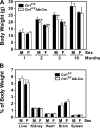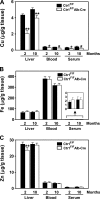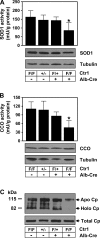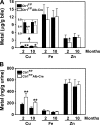Deletion of hepatic Ctr1 reveals its function in copper acquisition and compensatory mechanisms for copper homeostasis
- PMID: 19095764
- PMCID: PMC2643901
- DOI: 10.1152/ajpgi.90632.2008
Deletion of hepatic Ctr1 reveals its function in copper acquisition and compensatory mechanisms for copper homeostasis
Abstract
Copper is a vital trace element required for normal growth and development of many organisms. To determine the roles for copper transporter 1 (Ctr1) in hepatic copper metabolism and the contribution of the liver to systemic copper homeostasis, we have generated and characterized mice in which Ctr1 is deleted specifically in the liver. These mice express less than 10% residual Ctr1 protein in the liver and exhibit a small but significant growth retardation, which disappears with age. Hepatic copper concentrations and the activities of copper-requiring enzymes are reduced; however, mild copper deficiency relative to Ctr1 protein deficit indicates compensatory mechanisms for copper metabolism. Copper concentrations of other organs did not alter despite the defect in hepatic copper uptake. Whereas biliary copper excretion is reduced, urinary copper concentration in these mice is higher than that of control mice. Our data indicate that Ctr1 plays a critical role in copper acquisition in the liver, and, when Ctr1 expression is compromised, compensatory mechanisms facilitate copper uptake and/or retention in the liver and excretion of copper via urine.
Figures





References
-
- Bertinato J, Swist E, Plouffe LJ, Brooks SP, L'abbé MR. Ctr2 is partially localized to the plasma membrane and stimulates copper uptake in COS-7 cells. Biochem J 409: 731–740, 2008. - PubMed
-
- Brewer GJ Zinc acetate for the treatment of Wilson's disease. Expert Opin Pharmacother 2: 1473–1477, 2001. - PubMed
-
- Brewer GJ Copper control as an antiangiogenic anticancer therapy: lessons from treating Wilson's disease. Exp Biol Med (Maywood) 226: 665–673, 2001. - PubMed
-
- Capaldi RA, Marusich MF, Taanman JW. Mammalian cytochrome-c oxidase: characterization of enzyme and immunological detection of subunits in tissue extracts and whole cells. Methods Enzymol 260: 117–132, 1995. - PubMed
-
- Cobine PA, Pierrel F, Winge DR. Copper trafficking to the mitochondrion and assembly of copper metalloenzymes. Biochim Biophys Acta 1763: 759–772, 2006. - PubMed
Publication types
MeSH terms
Substances
Grants and funding
LinkOut - more resources
Full Text Sources
Molecular Biology Databases
Research Materials

